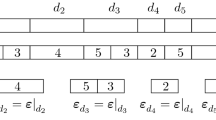Abstract
In the problem of random genetic drift, the probability density of one gene is governed by a degenerated convection-dominated diffusion equation. Dirac singularities will always be developed at boundary points as time evolves, which is known as the fixation phenomenon in genetic evolution. Three finite volume methods: FVM1-3, one central difference method: FDM1 and three finite element methods: FEM1-3 are considered. These methods lead to different equilibrium states after a long time. It is shown that only schemes FVM3 and FEM3, which are the same, preserve probability, expectation and positiveness and predict the correct probability of fixation. FVM1-2 wrongly predict the probability of fixation due to their intrinsic viscosity, even though they are unconditionally stable. Contrarily, FDM1 and FEM1-2 introduce different anti-diffusion terms, which make them unstable and fail to preserve positiveness.











Similar content being viewed by others
References
Crow, J.F., Kimura, M.: An Introduction to Population Genetics Theory. Harper & Row, New York (1970)
Der, R., Epstein, C.L., Plotkin, J.B.: Generalized population models and the nature of genetic drift. Theor. Popul. Biol. 80(2), 80–99 (2011)
Duan, C., Liu, C., Wang, C., Yue, X.: Numerical complete solution for random genetic drift by energetic variational approach. arXiv:1803.09436. Mathematical modelling and numerical analysis accepted and published online (2018) https://doi.org/10.1051/m2an/2018058
Eymard, R., Gallouët, T., Herbin, R.: The finite volume method. In: Ciarlet, P., Lions, J.L. (eds.) Handbook for Numerical Analysis, pp. 715–1022. North Holland, Amsterdam (2000)
Fisher, R.A.: On the dominance ratio. Proc. R. Soc. Edinb. 42, 321–431 (1922)
Hössjer, O., Tyvand, P.A., Miloh, T.: Exact Markov chain and approximate diffusion solution for hapliod genetic drift with one-way mutation. Math. Biosci. 272, 100–112 (2016)
Kimura, M.: Stochastic processes and distribution of gene frequencies under natural selection. Cold Spring Harb. Symp. Quant. Biol. 20, 33–53 (1955)
Kimura, M.: Random genetic drift in multi-allelic locus. Evolution 9(4), 419–435 (1955)
Kimura, M.: On the probability of fixation of mutant genes in a population. Genetics 47(6), 713–719 (1962)
Kimura, M.: Diffusion models in population genetics. J. Appl. Probab. 1, 177–232 (1964)
Kimura, M.: The Neutral Theory of Molecular Evolution: A Review of Recent Evidence. Cambridge University Press, Cambridge (1983)
LeVeque, R.: Finite-Volume Methods for Hyperbolic Problems. Cambridge University Press, Cambridge (2002)
McKane, A.J., Waxman, D.: Sigular solution of the diffusion equation of population genetics. J. Theor. Biol. 247, 849–858 (2007)
Moran, P.A.P.: Random processes in genetics. Proc. Camb. Philos. Soc. 54, 60–72 (1958)
Roos, H.G., Stynes, M., Tobiska, L.: Numerical Methods for Singularly Perturbed Differential Equations. Springer, New York (1996)
Thomee, V.: Galerkin Finite Element Methods for Parabolic Problems. Springer Series in Computational Mathematics, vol. 25. Springer, New York (2006)
Tran, T.D., Hofrichter, J., Jost, J.: A general solution of the Wright-Fisher model of random genetic drift. Differ. Equ. Dyn. Syst. (2012). https://doi.org/10.1007/s12591-016-0289-7
Tran, T.D., Hofrichter, J., Jost, J.: An introduction to the mathematical structure of the Wright–Fisher model of population genetics. Theory Biosci. 132, 73–82 (2013)
Waxman, D.: Fixation at a locus with multiple alleles: structure and solution of the Wright Fisher model. J. Theor. Biol. 257, 245–251 (2009)
Wright, S.: The evolution of dominace. Am. Nat. 63(689), 556–561 (1929)
Wright, S.: The differential equation of the distribution of gene frequencies. Proc. Natl. Acad. Sci. U.S.A. 31, 382–389 (1945)
Zhao, L., Yue, X., Waxman, D.: Complete numerical solution of the diffusion equation of random genetic drift. Genetics 194(4), 973–985 (2013)
Acknowledgements
The authors benefitted a great deal from discussions with Prof. David Waxman, Prof. Xinfu Chen and Prof. Xiaobing Feng. The authors thank the anonymous referees for their most valuable comments which improve the paper.
Author information
Authors and Affiliations
Corresponding author
Additional information
Communicated by Elisabeth Larsson.
Publisher's Note
Springer Nature remains neutral with regard to jurisdictional claims in published maps and institutional affiliations.
Partially supported by NSF of China Grants 11271281, 11301368 and 91230106 and by NSF Grants DMS-1159937, DMS-1216938 and DMS-1109107.
Rights and permissions
About this article
Cite this article
Xu, S., Chen, M., Liu, C. et al. Behavior of different numerical schemes for random genetic drift. Bit Numer Math 59, 797–821 (2019). https://doi.org/10.1007/s10543-019-00749-4
Received:
Accepted:
Published:
Issue Date:
DOI: https://doi.org/10.1007/s10543-019-00749-4
Keywords
- Random genetic drift
- Degenerate equation
- Conservations of probability and expectation
- Finite volume method
- Finite difference method
- Finite element method
- Numerical viscosity and numerical anti-diffusion




